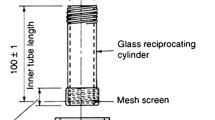Abstract
The objective of this work was to examine the feasibility of developing a high-performance computing software system to simulate the United States Pharmacopeia (USP) dissolution apparatus 2 (paddle apparatus) and thus aid in characterizing the fluid hydrodynamics in the method. The USP apparatus was modeled using the hydrodynamic package Fluent. The Gambit program was used to create a “wireframe” of the apparatus and generate the 3-dimensional grids for the computational fluid dynamics solver. The Fluent solver was run on an IBM RS/6000 SP distributed memory parallel processor system, using 8 processors. Configurations with and without a tablet present were developed and examined. Simulations for a liquid-filled vessel at a paddle speed of 50 rpm were generated. Large variations in fluid velocity magnitudes with position in the vessel were evident. Fluid velocity predictions were in good agreement with those previously published, using laser Doppler velocity measurements. A low-velocity domain was evident directly below the center of the rotating paddle. The model was extended to simulate the impact of the presence of a cylindrical tablet in the base of the dissolution vessel. The presence of the tablet complicated the local fluid flow, and large fluid shear rates were evident at the base of the compact. Fluid shear rates varied depending on the tablet surface and the location on the surface and were consistent with the reported asymmetrical dissolution of model tablets. The approach has the potential to explain the variable dissolution results reported and to aid in the design/prediction of optimal dissolution conditions for in vitro-in vivo correlations.
Similar content being viewed by others
References
Levy G. Effect of certain tablet formulation factors on dissolution rate of the active ingredient I. J Pharm Sci. 1963;52:1039–1046.
Kamba M, Seta Y, Kusai A, Nishimura K. Comparison of the mechanical destructive force in the small intestine of dog and human. Int J Pharm. 2002;237(1–2):139–149.
Rohrs BR, Skoug JW, Halstead GW. Dissolution assay development for in vitro-in vivo correlations. In: Young D, Devane JG, Butler JB, eds. In Vitro-In Vivo Correlations. New York, NY: Plenum Press; 1997;17–30.
USP 26, The United Stated Pharmacopeia. Rockville, MD: United States Pharmacopeial Convention Inc. 2003:2155–2156.
Healy AM, McCarthy LG, Gallagher KM, Corrigan OI. Sensitivity of dissolution rate to location in the paddle dissolution apparatus. J Pharm Pharmacol. 2002;54:441–444.
Levy G. Effect of dissolution rate on absorption, metabolism and pharmacologic activity of drugs. J Mond Pharm. 1967;3:237–254.
Stricker H. In vitro studies on the dissolution and absorption behaviour of orally administered drugs and the comection to their bioavailability. In: Deasy PB, Timoney RF, edds. The Quality Control of Medicines. Amsterdam, The Netherlands. Elsevier Scientific Publishing Company; 1976:253–271.
Weiss A, Pitman ER, Graham EC. Aspirin and gastric bleeding: gastroscopic observations, with review of literature. Am J Med. 1961;31:266–278.
Levy G, Leonards JR, Procknal JA. Development of in vitro dissolution tests which correlate quantitatively with dissolution rate-limited drug absorption in man. J Pharm Sci. 1965;54:1719–1722.
Scholz A, Abrahamsson B, Diebold SM, Kostewicz E, Polentarutti BI, Ungell A-L, Dressman JB. Influence of hydrodynamics and particle size on the absorption of felodipine in labradors. Pharm Res. 2002;19:42–46.
Bocanegra LM, Morris GJ, Jurewicz JT, Mauger JW. Fluid and particle laser Doppler velocity measurements and mass transfer predictions for the USP paddle method dissolution apparatus. Drug Dev Ind Pharm. 1990;16:1441–1464.
Diebold SM, Dressman JB. Hydrodynamik kompendialer Lösungsgeschwindigkeits-Testapparaturen. Pharm Ind. 2001;63:94–104.
Fluent5 Users Guide. Vols 1–4. Canterra Resource Park, NH: Fluent Incorporated; 1998.
Munson BR, Young DF, Okiishi TH. Fundamentals of Fluid Mechanics. New York, NY. John Wiley & Sons Inc. 1998;309–365.
Visawanth DS, Natarajan G. Data Book on the Viscosity of Liquids. New York, NY: Hemisphere Publishing Corporation. 1989:41–45, 714–715.
Diebold SM. Hydrodynamik and Lösungsgeschwindigkeit [dissertation] Frankfurt, Germany: Wolfgang Goethe-Universität, 2000.
Bocanegra LM. A Two Phase Flow Experim ental Study of the United States Pharmacopeia Paddle Method, Dissolution Test Apparatus [disseration]. Morgantown, WV: West Virginia University. 1988.
Beckett AN, Quach TT, Kurs GS. Improved hydrodynamics for USP apparatus 2. Dissolut Technol. 1996;3:7–10.
Qureshi SA, Shabnam J. Cause of high variability in drug dissolution testing and its impact on setting tolerances. Eur J Pharm Sci. 2001;12:271–276.
Cox DC, Wells CE, Furnam WB, Savage TS, King AC. Systematic error associated with apparatus 2 of the USP dissolution test, II: effects of deviations in vessel curvature from that of a sphere. J Pharm Sci. 1982;71:395–399.
Achanta AS, Gray VA, Cecil TL, Grady LT. Evaluation of the performance of prednisone and salicylic acid calibrators. Drug Dev Ind Pharm. 1995;21:1171–1182.
Qureshi SA, McGilveray IJ. Typical variability in drug dissolution testing: study with USP and FDA calibrator tablets and a marketed drug (glibenclamide) product. Eur J Pharm Sci. 1999;7:249–258.
Author information
Authors and Affiliations
Corresponding author
Rights and permissions
About this article
Cite this article
McCarthy, L.G., Kosiol, C., Healy, A.M. et al. Simulating the hydrodynamic conditions in the united states pharmacopeia paddle dissolution apparatus. AAPS PharmSciTech 4, 22 (2003). https://doi.org/10.1208/pt040222
Received:
Accepted:
DOI: https://doi.org/10.1208/pt040222




